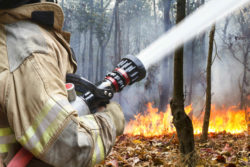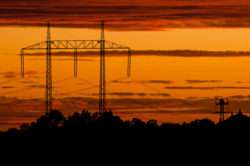Top Class Actions’s website and social media posts use affiliate links. If you make a purchase using such links, we may receive a commission, but it will not result in any additional charges to you. Please review our Affiliate Link Disclosure for more information.

Documents Show PG&E Ignored Failing Equipment for Years
According to an article published by the Wall Street Journal on July 10, 2019, the newspaper obtained internal documents indicating that the Pacific Gas and Electric Company (PG&E) has known for years that hundreds of miles of its high voltage power lines were at risk of failing and sparking fires.
According to a CBS news report, the documents, obtained under the Freedom of Information Act, allegedly show that the company was aware that hundreds of miles of power lines were old, unmaintained, and in disrepair. Power lines that are too old or damaged may be dangerous and lead to sparks and wildfires.
The infamous Camp Fire, the most destructive fire in California history, was reportedly caused by a failure in a power line that was approximately 100 years old. This power line, known as the Caribou-Palermo, was built in 1921. The line was permanently shut down following the Camp Fire due to the amount of work necessary to repair the line to make it safe to operate again.
Additionally, documents have been uncovered indicating that the company was aware before the fire that almost 50 percent of the steel towers carrying the Caribou-Palermo line were in dire need of replacement.
The Caribou-Palermo power line is reportedly not the only piece of ancient equipment still in use by PG&E.
According to an internal presentation from PG&E in 2017, the company estimated that the average age of its transmission towers was 68 years old. These towers are meant to have a life expectancy of 65 years. Some of the towers included in the presentation were almost 110.
Reportedly, these towers have not been regularly inspected by PG&E until recently.
Outside consultants hired by the company have recommended for years that PG&E regularly climb and inspect these towers to ensure their safety and complete repairs. However, the company reportedly did not implement these suggestions until after the devastation of the Camp Fire. Following the fire, PG&E has also begun to utilize drones and helicopters in its inspection of the towers.
Despite these safety measures, the damage has already been done to more than 100 acres of California land.
According to internal PG&E documents, the company appears to be unaware of the exact age of many of its transmission towers and lines.
In 2010, the company hired consulting firm Quanta Technology to assess and condition of many of their towers. Although the firm was unable to accurately assess the age of nearly 7,000 towers, it found that around 60 percent of the remaining towers were built between 1920 and 1950, and 30 percent were built between 1900 and 1920.
PG&E is not the only utilities company to fail to regularly inspect equipment. Much of the power infrastructure in the United States was built in the early 1900s, meaning that there may be countless steel towers and power lines that are past the end of their expected life spans. Other California utilities companies, including Southern California Edison, have also been accused of starting wildfires due to old or faulty equipment.
Following the release of the Wall Street Journal’s report, Mercury News reports that U.S. District Judge William Alsup has ordered the utilities company to provide a point by point response to the accusations listed in the article, as well as a full itemization of the company’s political giving since 2017. According to the judge, PG&E must explain “why those campaign contributions were more important [than] replacing or repairing the aging transmission lines described by The Wall Street Journal article and removing or trimming the backlog of hazard trees, and increasing vegetation management.”
California Wildfire Law Puts Responsibility on PG&E and Customers
California Governor Gavin Newsom reportedly signed a bill on July 12 to allocate up to $26 billion to prevent wildfire risks in the state. Under the bill, investor-owned utilities will be provided with at least $21 billion to pay for destruction and damage caused by California wildfires linked to faulty utilities equipment.
Utility customers will also be required to pay $10.5 billion to a wildfire fund through a charge that already exists on consumer’s monthly bills. This charge was expected to expire by 2021, but has been authorized for another 15 years in order to secure additional funding for wildfire damages. The charge is approximately $2 a month per consumer.
However, some people believe that this bill will do nothing more than buy time.
The LA Times reports that Steven Weissman, a lecturer at the Goldman School of Public Policy at UC Berkeley, expects that PG&E residential customers may see their bills double within 8 years if California wildfire trends continue.
Unless state laws change to hold utilities companies accountable for ensuring the safety of their equipment, customers will continue to suffer the consequences, and wildfires may become more frequent, leading to lasting damage to California’s environment.
Background on Pacific Gas and Electric Company
PG&E is a utility company supplying natural gas and electricity to 16 million people from the Sierra Nevada to the San Francisco Bay Area. It operates one of the oldest long-distance electrical transmission networks in the world. Many of the steel towers operated by PG&E were built in the early 1900s and are still in use today. These towers and power lines cover approximately 70,000 square miles.
PG&E filed for bankruptcy protection in January 2019, due to the more than $30 billion they may owe due to pending lawsuits from victims, and other claims regarding their responsibility in the ignition of the Camp Fire and other destructive California wildfires. Although consumer advocates have argued that bailing out the company is tantamount to rewarding PG&E’s failure to ensure their power lines were safe, the company and its stakeholders claim that allowing the utilities company to go bankrupt would be an even worse option for consumers.
Additionally, in April 2019 the company asked California regulators to increase electricity and natural gas rates for consumers. Under the new proposed rates, consumers’ bills would increase by more than $20 a month.
Despite the toll that these fires have taken on California’s communities, customers are still expected to subsidize the costs of these devastating fires. According to USA Today, California Assemblymember and Democrat Marc Levine of San Rafael stated in regards to the recent bill that will require PG&E customers to pay a monthly fee to finance a wildfire fund, “It is hard not to see this bill as something of a reward for monstrous behavior.”
Background on the Camp Fire
The Camp Fire was the most destructive fire in California history. The fire started on Nov. 8, 2018 after sparks from a power line owned by PG&E ignited the dry vegetation nearby and started a wildfire. The fire burned for 17 days across more than 150,000 acres. The total land affected by the Camp Fire totaled approximately 240 square miles, an area approximately the size of Chicago.
The Camp Fire destroyed 18,804 buildings and structures, including 14,000 homes, and caused approximately $16.5 billion in damage. In addition to being one of the world’s most costly natural disasters in 2018, the fire was also the deadliest wildfire in California history and sixth deadliest in the United States. At least 85 civilians were killed due to the fire, and another 18 were injured.
Due to the massive costs associated with the blaze, PG&E filed for Chapter 11 bankruptcy soon after the fire was contained.
In addition to the financial costs of the Camp Fire, there have also been costs to California’s communities.
Approximately 50,000 people were reportedly displaced by the fire, leading to a drop in the rental market’s vacancy rate, worsening California’s housing crisis, and leaving thousands struggling to find somewhere to stay. The town of Paradise lost over 90 percent of its population since the fire destroyed most of the town last year. Paradise used to be home to about 26,800 people, most of whom were retired. As of April 2019, the town is reportedly down to 2,034 residents.
In addition to the housing crisis caused by the Camp Fire, California residents may also have suffered from property and tree damage due to the fire. Approximately 1,000 structures were destroyed by the fire, and thousands more were damaged.
Camp Fire also destroyed trees, fencing, landscaping, and natural vegetation. While some of these damages may be covered by insurance policies, trees and landscaping are generally not covered by these policies.
Now that PG&E has reportedly been found to be responsible for the Camp Fire, many California residents who were displaced or suffered property damage due to the blaze have filed lawsuits against the utilities company.
Hundreds of lawsuits have been filed against PG&E by victims seeking compensation for damages to homes, property, landscaping, fencing, outbuildings, vegetation, and more.
If you are a California resident who has suffered losses due to the Camp Fire or other California wildfires, legal help may be available to you. Filing a lawsuit against the utilities companies responsible for these fires may be the first step is seeking accountability, change, and compensation.
Join a Free California Wildfire Property Damage Lawsuit Investigation
If you or a loved one suffered property damage in the Camp Fire, Woolsey Fire, Hill Fire or last year’s Thomas Fire, legal help is available to help you through the claim process with your insurance company.
This article is not legal advice. It is presented
for informational purposes only.
ATTORNEY ADVERTISING
Top Class Actions is a Proud Member of the American Bar Association
LEGAL INFORMATION IS NOT LEGAL ADVICE
Top Class Actions Legal Statement
©2008 – 2024 Top Class Actions® LLC
Various Trademarks held by their respective owners
This website is not intended for viewing or usage by European Union citizens.
Get Help – It’s Free
Join a Free California Wildfire Property Damage Lawsuit Investigation
If you qualify, an attorney will contact you to discuss the details of your potential case at no charge to you.
PLEASE NOTE: If you want to participate in this investigation, it is imperative that you reply to the law firm if they call or email you. Failing to do so may result in you not getting signed up as a client or getting you dropped as a client.
E-mail any problems with this form to:
Questions@TopClassActions.com.
Oops! We could not locate your form.













